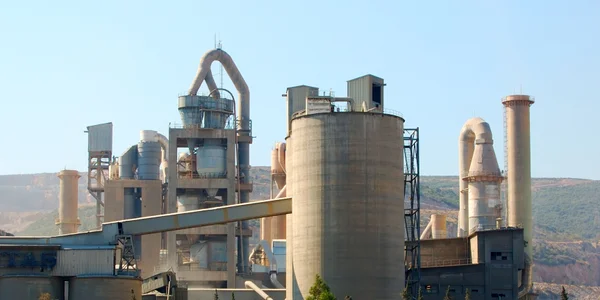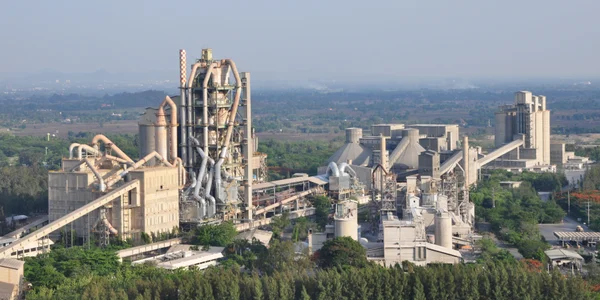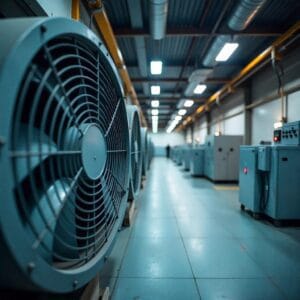Ofislar
Shtab-kvartira

Germaniya
- Intensiv Filter Himenviro Technologies GmbH
Neustraße 45 - 49, 42553, Velbert, Deutschland/Germaniya - +49 20534200990
VILOYAT BOSHQARMASI
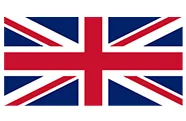
Buyuk Britaniya
- Intensiv filtri Himenviro UK Limited
47, Bath Street WS13BX, Wallsall West Midlands, Buyuk Britaniya - +44 1922 628893
VILOYAT BOSHQARMASI

Birlashgan Arab Amirliklari
- Intensiv filtri Himenviro Technologies FZE – MChJ
Biznes markazi, Sharja Publishing City erkin zonasi, Sharja, BAA - +971-556074697
VILOYAT BOSHQARMASI

Hindiston
- Intensiv-Filtr Himenviro Private Limited
D-247/11, Sektor-63, Noida - 201301, Uttar-Pradesh, Hindiston - +91-120-4642-500
VILOYAT BOSHQARMASI

Hindiston
- Intensiv-Filtr Himenviro Private Limited
D-247/11, Sektor-63, Noida - 201301, Uttar-Pradesh, Hindiston - +91-120-4642-500
VILOYAT BOSHQARMASI

Hindiston
- Intensiv-Filtr Himenviro Private Limited
D-247/11, Sektor-63, Noida - 201301, Uttar-Pradesh, Hindiston - +91-120-4642-500
Oziq-ovqat sanoati havo va chang filtrlash yechimlari
Oziq-ovqat va ichimliklar sanoati aniq jarayonlar va qat'iy gigiena standartlariga tayanadigan murakkab va yuqori darajada tartibga solinadigan sektor. Ushbu standartlarni saqlashning muhim jihatlaridan biri changni samarali nazorat qilishdir. Donni qayta ishlash, aralashtirish, aralashtirish va qadoqlash kabi jarayonlar mahsulotlarni ifloslantirishi, ishchilarning sog'lig'iga xavf tug'dirishi va portlash xavfini tug'dirishi mumkin bo'lgan mayda chang zarralarini hosil qiladi.
Bu muammolarni hal qilish uchun, Biz ilg'or taklif filtrlash eritmalari oziq-ovqat va ichimliklar sanoati uchun maxsus ishlab chiqilgan. Bizning tizimlarimiz chang zarralarini ushlash va olib tashlash, mahsulot tozaligini, ishchilar xavfsizligini va me'yoriy hujjatlarga muvofiqligini ta'minlash uchun ishlab chiqilgan.
Oziq-ovqat sanoatida changni filtrlash jarayoni
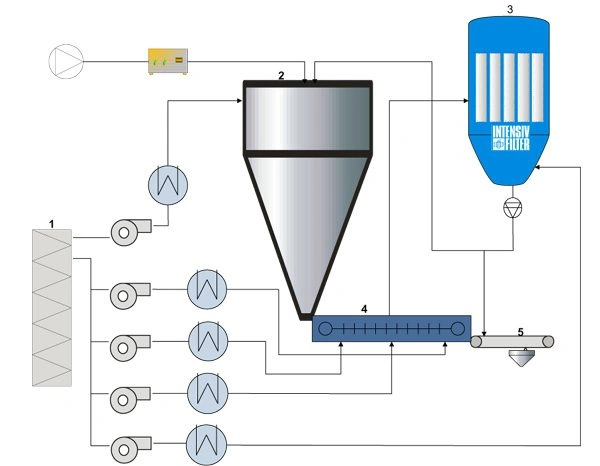
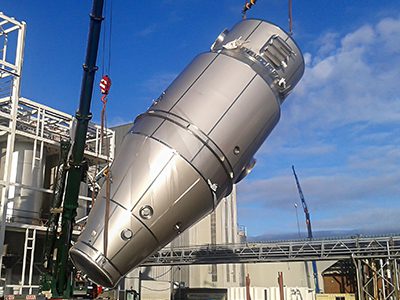
- 1. Tashqi filtr
- 2. Spray quritgich
- 3. CIP filtri
- 4. Tashqi suyuqlashtirilgan yotoq
- 5. To'ldirish
CIP filtri uchun talab qilinadigan spetsifikatsiya
Oddiy dizayn ma'lumotlari | CIP filtri |
|---|---|
Gaz hajmi | < 230 000 m³/soat |
Gaz harorati | 80-90 ° S |
Chang turi | Quritilgan sut mahsulotlari |
Qoldiq chang tarkibi | < 10 g/m³ |
Xom gazning chang tarkibi | 20 mg/m³ |
Tozalash | Onlayn |
Filtr muhiti | Polyester |
Portlash darajasiga ega dizayn | Ha |
Sorbent |
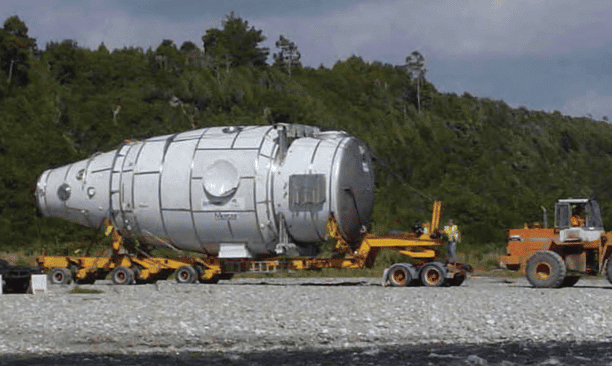
Oziq-ovqat sanoati uchun mahsulotlarimiz ilovasi

Donlar, kukunlar va bo'laklar kabi quyma materiallarni o'tkazish paytida hosil bo'lgan changni ushlang.
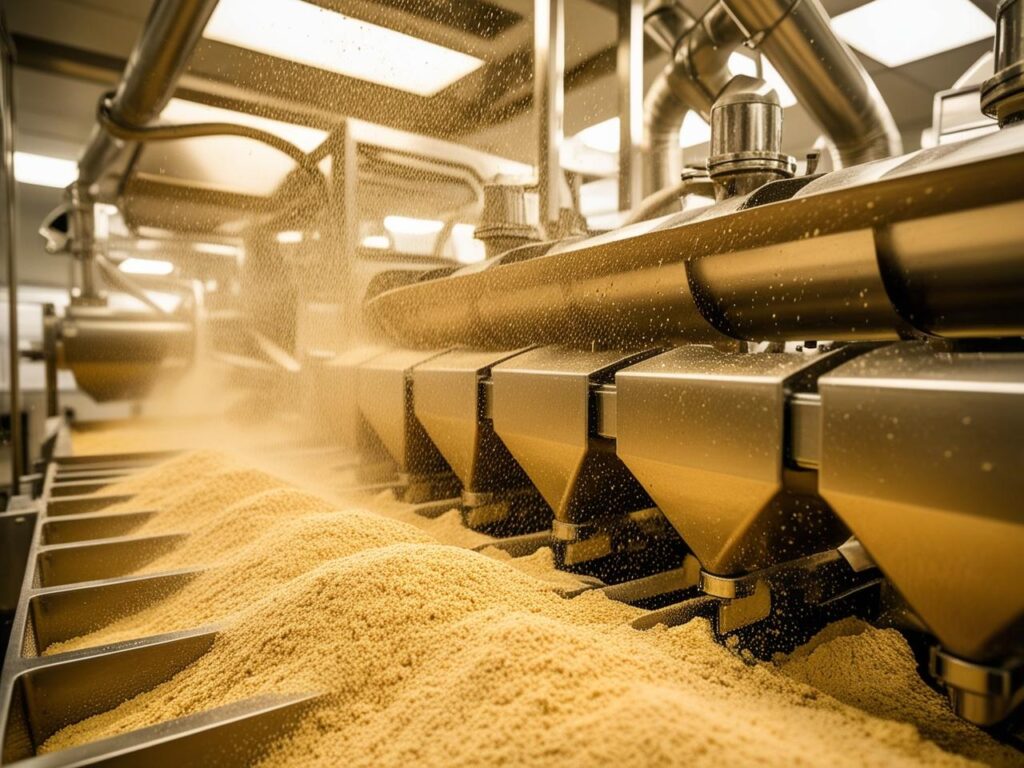
Tegirmon, maydalash va maydalash kabi yuqori energiyali jarayonlardan chang chiqindilarini nazorat qiling.
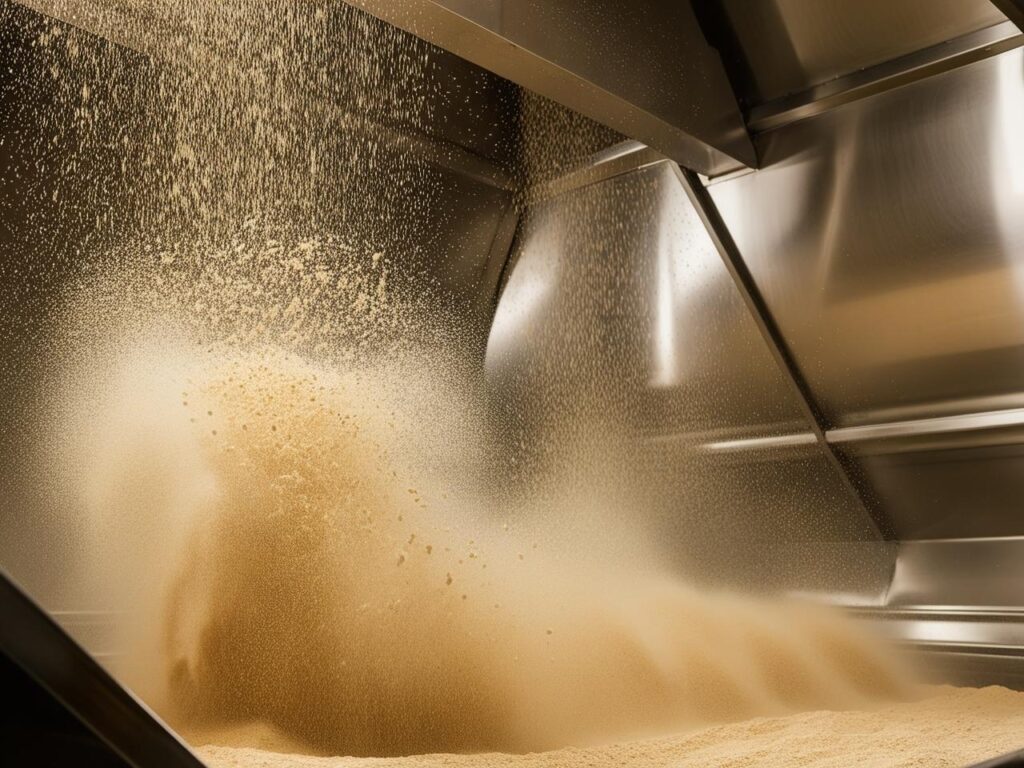
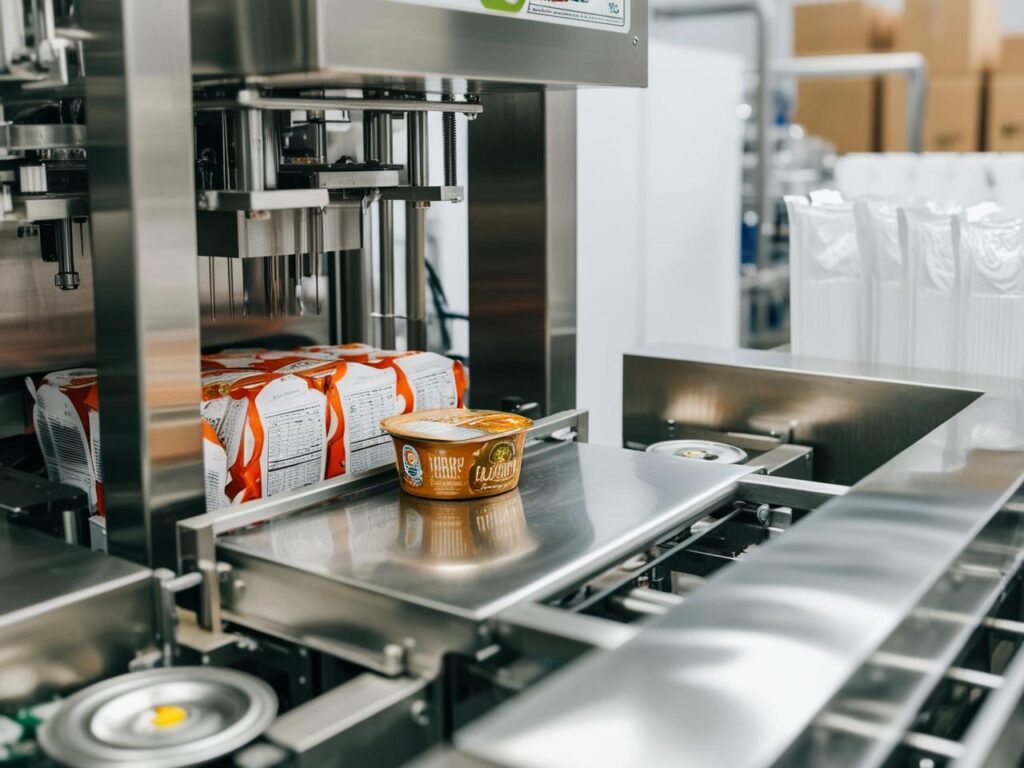
Changni nazorat qilish uchun tartibga soluvchi landshaft |
|---|
Oziq-ovqat xavfsizligi qoidalari |
FDA va USDA standartlariga rioya qilish |
Ishchilar salomatligi va xavfsizligi |
OSHA qoidalariga muvofiqligi |
Yong'in va portlashning oldini olish |
NFPA standartlarini joriy etish |
Atrof-muhitni muhofaza qilish |
Mahsulot sifati va izchilligi |
To'xtab qolish muddati va texnik xizmat ko'rsatish xarajatlari kamayadi |
Changni nazorat qilish muammolari |
|---|
Mahsulotning ifloslanishi |
Ishchilar salomatligi uchun xavflar |
Yong'in va portlash xavfi |
Normativ muvofiqlik |
O'zaro kontaminatsiya |
Mikroblarning o'sishi |
Oziq-ovqat xavfsizligiga qat'iy rioya qilish |
Mahsulot sifatining pasayishi |
Uskunaning shikastlanishi |
Changni samarali nazorat qilish uchun asosiy fikrlar |
|---|
Samarali changni ushlashni amalga oshiring |
To'g'ri havo oqimi va bosimni ta'minlang |
Quritilgan sut mahsulotlari |
Yuqori samarali filtrlash tizimlaridan foydalaning |
Muntazam texnik xizmat ko'rsatish va tekshirish |
Sanoat standartlariga rioya qiling |
Changni nazorat qilish tizimini muntazam ravishda baholang |
Jarayonga xos mulohazalar |
Xatarlarni baholash va kamaytirish |
Mutaxassis maslahati uchun biz bilan bog'laning
Boshqa xizmatlarimiz bilan tanishing!
Tez-tez so'raladigan savollar
Oziq-ovqat mahsulotlarini qayta ishlashda keng tarqalgan filtrlash tizimlariga membranali filtrlar (mikrofiltratsiya, ultrafiltratsiya, nanofiltratsiya va teskari osmos kabi), chuqurlik filtrlari, faollashtirilgan uglerod filtrlari va ultrabinafsha (UV) yorug'lik tizimlari kiradi. Ushbu texnologiyalar fizik, kimyoviy va biologik ifloslantiruvchi moddalarni olib tashlash, mahsulotning tozaligi va xavfsizligini ta'minlash uchun qo'llaniladi.
Filtrlash tizimlari xom ashyo va mahsulotlardan ifloslantiruvchi moddalarni, shu jumladan mikroorganizmlar, zarrachalar va kimyoviy qoldiqlarni samarali olib tashlash orqali oziq-ovqat xavfsizligi standartlariga muvofiqligini ta'minlaydi. Ushbu tozalash jarayoni tartibga soluvchi talablarni qondirishga yordam beradi va yakuniy oziq-ovqat mahsulotlarida yuqori sifat standartlarini saqlab qoladi.
Filtrlash tizimlari kiruvchi zarrachalar, mikroorganizmlar va boshqa ifloslantiruvchi moddalarni ingredientlar va yakuniy mahsulotlardan olib tashlash orqali mahsulot sifati va mustahkamligini saqlaydi. Bu har bir partiyaning kerakli soflik va sifat standartlariga javob berishini ta'minlaydi, bu esa barcha mahsulotlarda ta'm, tashqi ko'rinish va xavfsizlikning bir xilligiga olib keladi.


